Goddesses and lions
GODDESSES ENTHRONED WITH LIONS
Generally they are Goddesses associated with mountains, towns and city walls, sources, fertile nature, and wild animals, especially lions. They are not decked out by husbands or by fathers and brought the abundance and the prosperity for all.
Female were first enthroned with lions, then males invadors copied their powers symbols. Lions are symbols of SUN and are often represented by SPHYNX too.
Follow me also on https://www.facebook.com/GloriousWomenPaleolithicAndNeolithicPast
https://www.youtube.com/watch?feature=player_embedded&v=WIQcXR3AFYc
https://www.youtube.com/watch?v=4FEyhSQK4DE
The Çatalhöyük "Dame aux fauves"
English : The Çatalhöyük "Dame aux fauves" is the most ancient one. She is a seated Goddess on a throne flanked by two leopards or lions. Also Çatal Höyük and Çatal Hüyük; çatal is turkish for "fork" and Höyük for "mound". It was a very large Neolithics and Charcolithic settlement in southern Anatolia. It existed from approximately 7500 BC to 5700 and knew agriculture yet. War and invadors did not exist, so the Goddess Priestess reigned only over her children who lived all their life in the house of their mother. The girls did not get married and chose their lovers who returned them furtive visits at night. There was no violence in the house nor in the society. The relations with the other villages were excellent for the exchanges of goods and to find lovers. As the whole planet was peaceful, the women practised the distant business for rare commodities. The agricultural work was feminine and collective, the inheritance of the ground also. The Lady is giving birth to a baby whose we see head between the thighs.
 French : La Dame aux fauves de Çatalhöyük est la plus ancienne. Çatal, mot turc, veut dire fourchette et HöYük le monticule. C'est une déesse assise sur un trône flanqué de deux léopards ou lions. La ville Néolithique/Chalcolithique a existé d'environ 7500 av. J.-C à 5700 et connaissait déjà l'agriculture. La Déesse Prêtresse régnait seule sur ses enfants qui vivaient toute leur vie dans la maison de leur mère. Les filles ne se mariaient pas et choisissaient leurs amants qui leur rendaient des visites furtives la nuit. Il n'y avait pas de violence dans la maison ni dans la société. Les relations avec les autres villages étaient excellentes pour les échanges de marchandises et pour trouver des amoureux. Comme la planète entière était pacifique, les femmes pratiquaient le commerce lointain pour les denrées rares. Le travail agricole était féminin et collectif, l'héritage de la terre aussi. La Dame est en train d'accoucher d'un bébé dont on voit la tête entre ses cuisses.
French : La Dame aux fauves de Çatalhöyük est la plus ancienne. Çatal, mot turc, veut dire fourchette et HöYük le monticule. C'est une déesse assise sur un trône flanqué de deux léopards ou lions. La ville Néolithique/Chalcolithique a existé d'environ 7500 av. J.-C à 5700 et connaissait déjà l'agriculture. La Déesse Prêtresse régnait seule sur ses enfants qui vivaient toute leur vie dans la maison de leur mère. Les filles ne se mariaient pas et choisissaient leurs amants qui leur rendaient des visites furtives la nuit. Il n'y avait pas de violence dans la maison ni dans la société. Les relations avec les autres villages étaient excellentes pour les échanges de marchandises et pour trouver des amoureux. Comme la planète entière était pacifique, les femmes pratiquaient le commerce lointain pour les denrées rares. Le travail agricole était féminin et collectif, l'héritage de la terre aussi. La Dame est en train d'accoucher d'un bébé dont on voit la tête entre ses cuisses.
Another Seated Goddess from Catal Huyuk, 5900 BCE
This Anatolian Mother Goddess evolved in Hurrian goddess Hannahannah who was also earlier associated with lions, and Sumerian Inanna and Greek and Roman Cybele, lion symbolises Ishtar, Assyrian goddess of war, and etc. See below some exemples...
Goddess Cybele enthroned with lions
Cybele
enthroned
in a chariot
drawn
by two lions
2nd half 2nd century BCE. Metropolitan Museum of Art.
The origin of the name Cybele is Phrygian, and it might mean “mountain mother.” Atalanta and her husband Hippomenes were transformed into lions by Cybele, which would be one possible account of why she is shown with lions, according to Book X of Ovid’s Metamorphoses. (Husband : patriarcal society yet, invadors war made marriages).
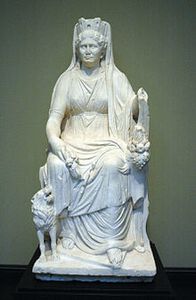 Cybele enthroned with lion. Roman marble, c. 50 CE. Getty Museum
Cybele enthroned with lion. Roman marble, c. 50 CE. Getty Museum
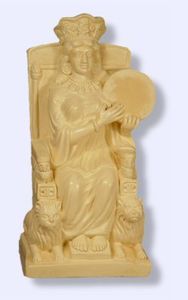 This Drumming Goddess was worshiped for thousands of years in Babylon, Egypt and Greece. Regally seated upon her lion-throne, we can sense her queenship as Magna Mater of Rome. During the transition to Christianity, Cybele's massive temple was replaced by St. Peter's Basilica. Celebrate the legacy of this Goddess of the Sacred Drum!
This Drumming Goddess was worshiped for thousands of years in Babylon, Egypt and Greece. Regally seated upon her lion-throne, we can sense her queenship as Magna Mater of Rome. During the transition to Christianity, Cybele's massive temple was replaced by St. Peter's Basilica. Celebrate the legacy of this Goddess of the Sacred Drum!
[Berlin Museum, c. 100 BCE] White marble-colored Gypsumstone.
 Roman, 1st-2nd century CE. Metropolitan Museum of Art.
Roman, 1st-2nd century CE. Metropolitan Museum of Art.
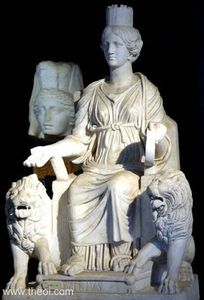 Rhea-Kybele, the mother of the gods, with turret crown, enthroned and flanked by lions.
Rhea-Kybele, the mother of the gods, with turret crown, enthroned and flanked by lions.
Others Evolved Goddesses enthroned with lions
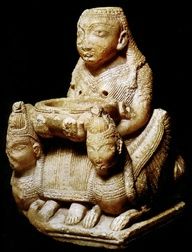 The Canaanite goddess is also shown seated between lions, which are now winged cherubim with lion's bodies and women's heads. Phoenicians brought this deity to southwestern Iberia. She is an alabaster ritual vessel; when libation is poured into her, the liquid shoots out from her breasts into the basin she holds. Tutugi, Spain, 7th century.
The Canaanite goddess is also shown seated between lions, which are now winged cherubim with lion's bodies and women's heads. Phoenicians brought this deity to southwestern Iberia. She is an alabaster ritual vessel; when libation is poured into her, the liquid shoots out from her breasts into the basin she holds. Tutugi, Spain, 7th century.
 Mater Matuta from the Estruscan city of Chiusi (4th c. BCE) -- In Roman religion, Mater Matuta was the goddess of the ripening of grain and of women fertility. Her worship in Italy was widespread and of ancient origin. The festival of the Mater Matuta (the Matralia) was held on June 11 and was marked by several unusual customs - among them that only free women in their 1st marriage might take part and that their prayers were not for their own children, but for those of their sisters.
Mater Matuta from the Estruscan city of Chiusi (4th c. BCE) -- In Roman religion, Mater Matuta was the goddess of the ripening of grain and of women fertility. Her worship in Italy was widespread and of ancient origin. The festival of the Mater Matuta (the Matralia) was held on June 11 and was marked by several unusual customs - among them that only free women in their 1st marriage might take part and that their prayers were not for their own children, but for those of their sisters.
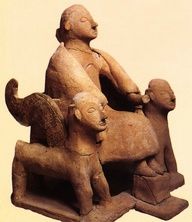 Enthroned Female Goddess of this type spread far and wide as the Greek and Roman world adopts veneration of the Mater Deum, Mother of the Gods. 7th C., Greek perhaps from Italy.
Enthroned Female Goddess of this type spread far and wide as the Greek and Roman world adopts veneration of the Mater Deum, Mother of the Gods. 7th C., Greek perhaps from Italy.
Egyptian Queen Cleopatra or Nefertiti Enthroned
 Cybele drawn in her chariot by lions towards a votive sacrifice (right). Above are the Sun God and heavenly objects. Plaque from Ai Khanoun, Bactria, (Afghanistan), 2nd century BCE
Cybele drawn in her chariot by lions towards a votive sacrifice (right). Above are the Sun God and heavenly objects. Plaque from Ai Khanoun, Bactria, (Afghanistan), 2nd century BCE
Cybele and Attis (seated right, with Phrygian cap shepherd's crook) in a chariot drawn by four lions, surrounded by dancing Corybantes (detail from the Parabiago plate; embossed silver, c. 200–400 CE, found in Milan, now at the Archlgcl Museum of Milan)
Isthar Lions
Usurpated lions thrones by males
Males were unable to invent their own Gods, they entirely copied on female ones, symbols and power, saying "that's me who invented" ! They lie all the time. And by the way, lost the real relationship with energetic cosmic spirits.
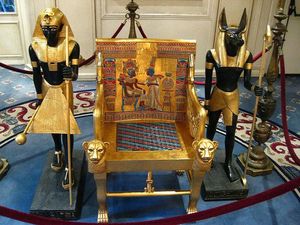 Trésor de la tombe du pharaon Toutankhamon [Toutânkhamon (né vers -1345, mort vers -1327) est le onzième pharaon de la XVIII dynastie (Nouvel Empire)]/ Part of the trousseau of the treasure of the tomb of the Pharaoh TUTANKAMON
Trésor de la tombe du pharaon Toutankhamon [Toutânkhamon (né vers -1345, mort vers -1327) est le onzième pharaon de la XVIII dynastie (Nouvel Empire)]/ Part of the trousseau of the treasure of the tomb of the Pharaoh TUTANKAMON
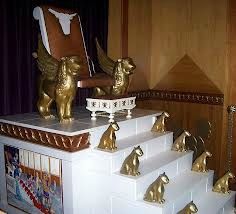 Scale Model of King Solomon's Throne. Tall Cedars Rooms in the George Washington Masonic Memorial. The conventional dates of Solomon's reign are circa 970 to 931 BC.
Scale Model of King Solomon's Throne. Tall Cedars Rooms in the George Washington Masonic Memorial. The conventional dates of Solomon's reign are circa 970 to 931 BC.


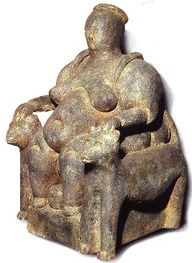

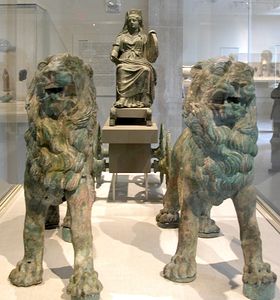


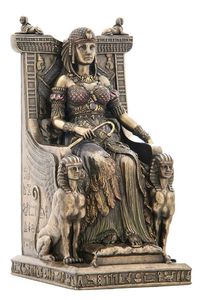
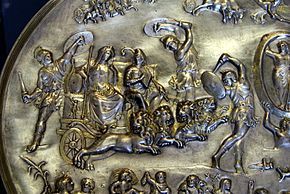




/https%3A%2F%2Fstorage.canalblog.com%2F02%2F96%2F1132185%2F109439579_o.jpg)
/https%3A%2F%2Fstorage.canalblog.com%2F73%2F95%2F1132185%2F109384986_o.jpg)
/https%3A%2F%2Fstorage.canalblog.com%2F83%2F79%2F1132185%2F95671429_o.jpg)
/https%3A%2F%2Fstorage.canalblog.com%2F09%2F75%2F1132185%2F94996351_o.jpg)